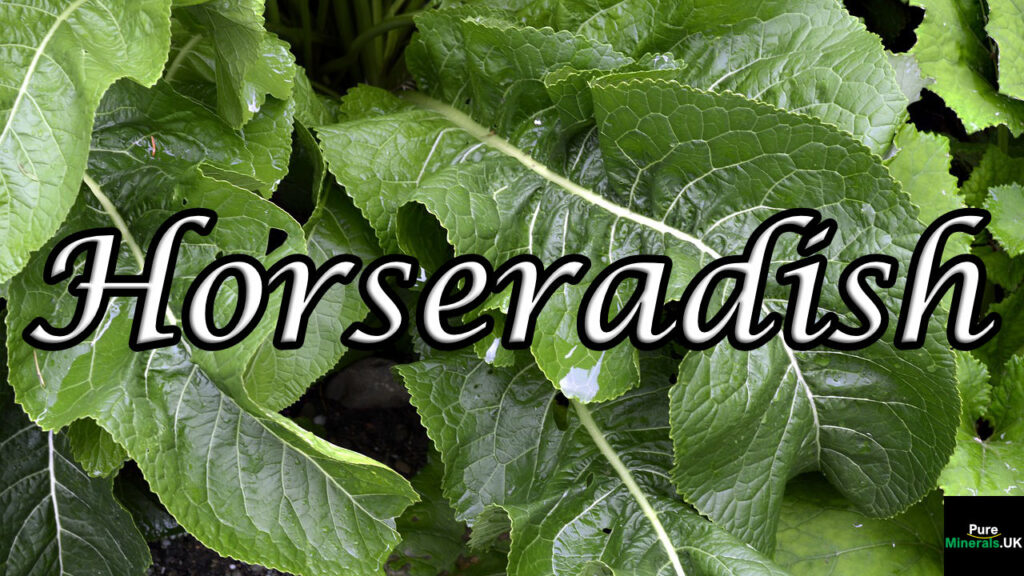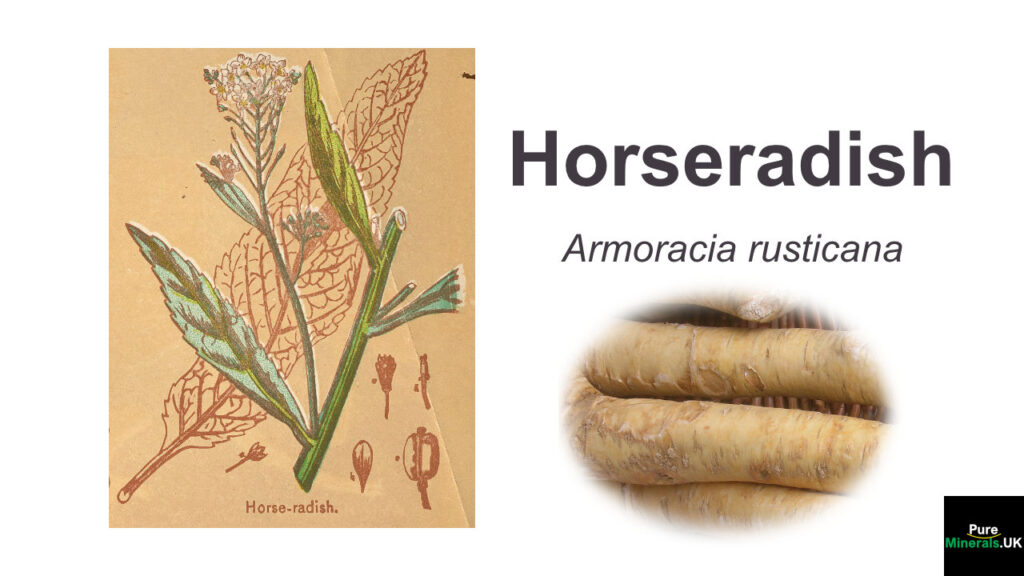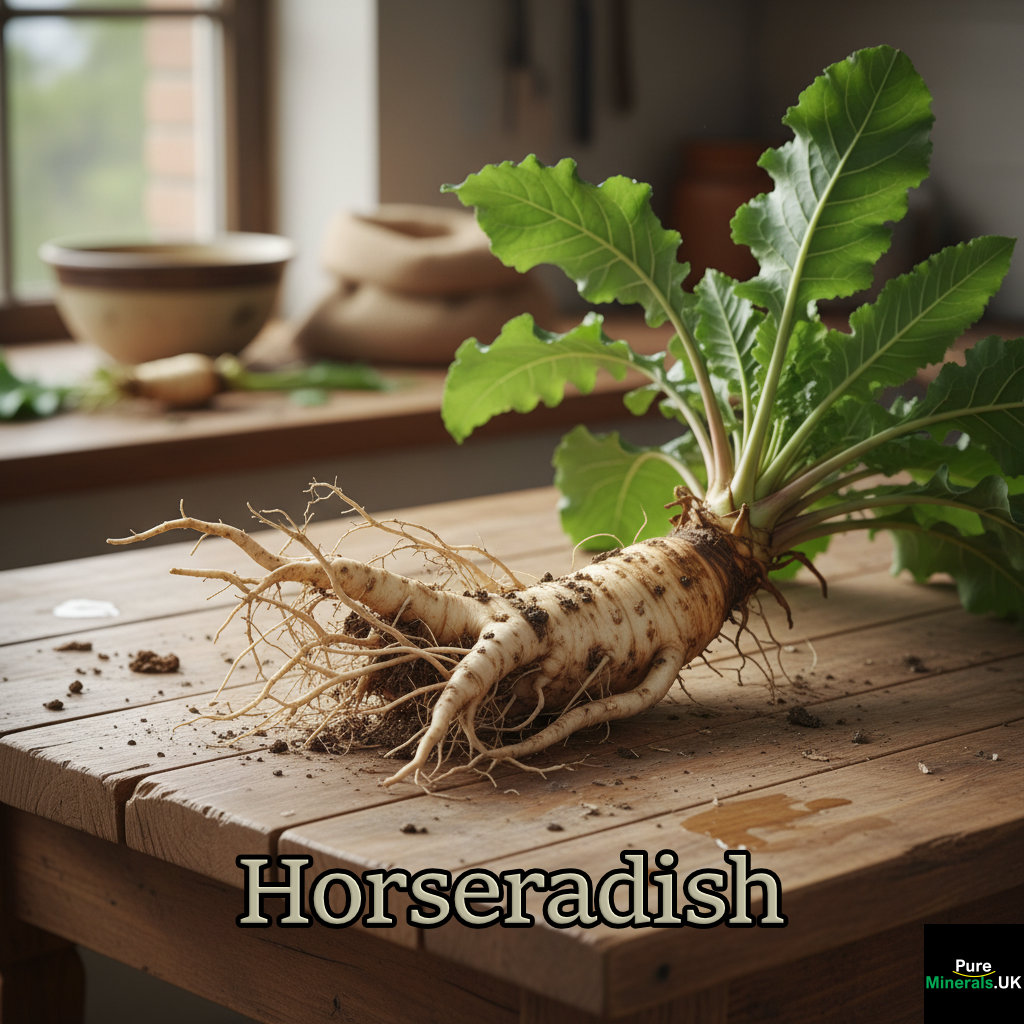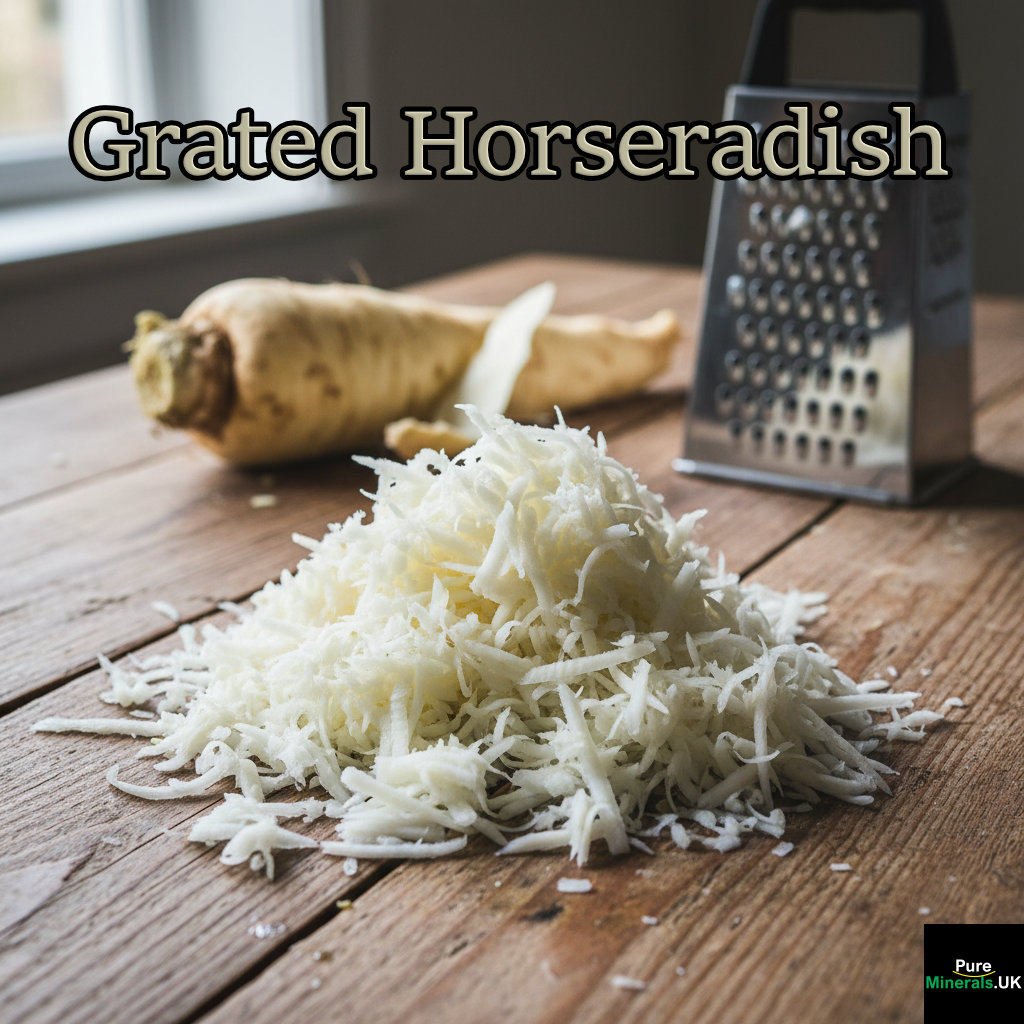
Article At-A-Glance
- Horseradish contains powerful compounds like isothiocyanates and sinigrin that can clear sinuses faster than many over-the-counter medications
- Research shows horseradish supplements can be as effective as traditional antibiotics for treating sinus infections and bronchitis
- The root’s digestive enzymes help break down fatty foods, making it an ideal pairing with rich meals
- Horseradish contains antibacterial compounds that can fight six types of oral bacteria and potentially prevent food poisoning
- Regular consumption of horseradish may provide anti-inflammatory and antioxidant benefits that support overall health

That familiar sinus-clearing burn of horseradish isn’t just a sensation – it’s your body experiencing one of nature’s most powerful decongestants in action. This unassuming root has been utilized by cultures worldwide for centuries as both a zesty condiment and a potent medicinal remedy. Sanat has been researching traditional remedies like horseradish for decades, documenting their impressive benefits when incorporated into modern wellness routines.
Unleash Your Sinuses: How Horseradish Works Its Magic

Anyone who’s taken a generous bite of horseradish knows the immediate effect – watering eyes, cleared sinuses, and that distinctive burn that seems to open airways instantly. This isn’t just a culinary experience; it’s a natural therapeutic process that has made horseradish a trusted remedy for respiratory issues throughout history.
The Science Behind the Burn: Isothiocyanates and Sinigrin
The sinus-clearing power of horseradish comes from specific compounds called isothiocyanates, which are released when the root is cut or crushed. These volatile compounds trigger a response in the mucous membranes, prompting the body to clear congestion. Sinigrin, another key compound in horseradish, converts to allyl isothiocyanate when the cell walls are broken, creating that familiar heat that opens nasal passages. The process is similar to how wasabi and mustard work, but horseradish delivers a particularly potent and prolonged effect that makes it especially effective for sinus relief.
Natural Decongestant Properties
Unlike many commercial decongestants that simply mask symptoms, horseradish actually helps your body expel mucus and reduce inflammation in the sinuses. The natural compounds stimulate blood circulation to the mucous membranes, helping to thin mucus secretions and make them easier to clear. This makes horseradish particularly valuable during cold and flu season or for those suffering from seasonal allergies. The decongestant effect works quickly, often providing relief within minutes of consumption – a benefit that has made it a go-to remedy for generations before commercial decongestants were available.
Speed of Relief Compared to Over-the-Counter Products
What sets horseradish apart from commercial decongestant products is how quickly it works. While many over-the-counter medications take 15-30 minutes to begin working, horseradish can start clearing congestion almost immediately upon consumption. One impressive study showed that a supplement containing 80 mg of dried horseradish root combined with nasturtium was as effective as a traditional antibiotic at treating acute sinus infections and bronchitis. This scientific validation confirms what traditional healers have known for centuries – horseradish provides powerful respiratory support without the side effects often associated with pharmaceutical options.
Digestive Power: Why Horseradish Makes Heavy Meals More Manageable
There’s a reason horseradish traditionally accompanies rich foods like prime rib, fatty fish, and heavy stews. Beyond its flavor-enhancing qualities, horseradish contains powerful digestive enzymes that help break down these challenging meals and make them easier for your body to process.
Breaking Down Fats and Oils
The pungent compounds in horseradish stimulate the production of bile, which is essential for the proper digestion of fats and oils. This makes horseradish an ideal companion for fatty cuts of meat or rich dairy-based dishes that might otherwise leave you feeling uncomfortably full. The root’s ability to cut through heaviness explains why cuisines worldwide have traditionally paired it with their most indulgent dishes – it’s not just about flavor, but about helping the body manage these foods more efficiently.
Stimulating Digestive Enzymes
Horseradish’s digestive benefits extend beyond bile production. It actively stimulates saliva production and increases the secretion of gastric juices and enzymes necessary for proper digestion. This enhanced enzymatic activity helps break down proteins and carbohydrates more efficiently, reducing common digestive complaints like bloating, gas, and that uncomfortable “food coma” feeling after indulgent meals. The root’s natural compounds trigger receptors in the mouth and digestive tract, essentially preparing your digestive system to work more efficiently.
Why Traditional Cultures Pair Horseradish with Rich Foods
The practice of serving horseradish alongside fatty meats and rich dishes isn’t just a flavor tradition—it’s functional food wisdom passed down through generations. European Jewish cuisine pairs horseradish with gefilte fish, British tables feature horseradish cream with roast beef, and Japanese cuisine incorporates wasabi (a horseradish relative) with fatty fish. These culinary traditions developed not just for taste but for their digestive benefits. The sharp, pungent qualities of horseradish cut through richness while simultaneously supporting the body’s ability to process these more challenging foods.
Seven Surprising Health Benefits Beyond Sinus Relief
While horseradish is best known for its sinus-clearing and digestive properties, research has uncovered numerous additional health benefits that make this root a true superfood. From fighting bacteria to potentially preventing serious diseases, horseradish delivers impressive health protection in every spicy bite.
1. Antibacterial Protection
The isothiocyanates in horseradish don’t just clear sinuses—they’re powerful antibacterial agents. Studies have shown that horseradish extract can effectively combat multiple bacterial strains, including those responsible for food poisoning, urinary tract infections, and respiratory ailments. One laboratory study demonstrated that horseradish compounds could kill six different types of oral bacteria, suggesting potential benefits for dental health. This natural antibacterial property explains why horseradish has historically been used to preserve foods and treat infections before modern antibiotics were available.
2. Respiratory Health Support
Beyond immediate congestion relief, horseradish supports overall respiratory health through multiple mechanisms. Its compounds help thin mucus secretions, making them easier to expel from the respiratory tract. The root’s anti-inflammatory properties reduce swelling in irritated respiratory tissues, while its antibacterial effects help combat respiratory infections. For those with chronic respiratory conditions like sinusitis or bronchitis, regular horseradish consumption may provide meaningful relief and support respiratory function over time.
3. Anti-inflammatory Properties
Horseradish contains sinigrin, a compound with proven anti-inflammatory effects. Research shows sinigrin works by blocking certain pathways in the immune system that trigger inflammation, potentially offering relief for inflammatory conditions throughout the body. This anti-inflammatory action works both locally (in the digestive and respiratory systems) and systemically, potentially benefiting conditions like arthritis, inflammatory bowel disease, and even cardiovascular inflammation. Unlike some pharmaceutical anti-inflammatories, horseradish provides these benefits without damaging the digestive tract—in fact, it supports it.
4. Antioxidant Power
The antioxidant content in horseradish is often overlooked but remarkably potent. These compounds help neutralize free radicals, the unstable molecules that damage cells and contribute to aging and disease development. Horseradish’s antioxidant profile includes vitamin C and various flavonoids that provide cellular protection. Regular consumption may help reduce oxidative stress throughout the body, potentially slowing age-related damage and supporting overall cellular health.
5. Potential Cancer-Fighting Compounds
Some of the most exciting research on horseradish involves its potential cancer-preventive properties. Several studies suggest that the glucosinolates and isothiocyanates in horseradish may inhibit the growth of cancer cells, particularly in the colon, lung, and stomach. These compounds appear to influence cell signaling pathways that regulate cancer cell growth and spread. While more human studies are needed, laboratory research shows that horseradish compounds can induce apoptosis (programmed cell death) in certain cancer cell lines, making this root a promising subject for ongoing cancer prevention research.
6. Improved Circulation
Horseradish stimulates blood flow through its natural warming properties, potentially benefiting cardiovascular health. The root’s compounds trigger vasodilation—the widening of blood vessels—which improves circulation, particularly in peripheral areas like the extremities. This enhanced blood flow can help deliver oxygen and nutrients more efficiently throughout the body, supporting overall tissue health. For those with mild circulatory issues like cold hands and feet or people seeking improved facial circulation, horseradish may provide natural support without the side effects of pharmaceutical vasodilators.
7. Nutrient-Rich Profile
Despite its potent flavor that means it’s consumed in small amounts, horseradish delivers an impressive nutrient profile. The root provides significant amounts of vitamin C, folate, potassium, calcium, magnesium, and zinc. It’s also a good source of dietary fiber, supporting digestive health beyond its enzymatic benefits. These nutrients work synergistically with horseradish’s bioactive compounds to support immune function, bone health, energy metabolism, and overall wellness, similar to the benefits of ginger.
How to Use Fresh Horseradish Root at Home

While prepared horseradish is widely available, nothing compares to the potency and versatility of freshly grated horseradish root. Working with the fresh root allows you to control the intensity and customize preparations to your specific needs, whether culinary or medicinal. With simple techniques, you can harness the full power of this remarkable plant right in your home kitchen. To learn more about the health benefits, visit Healthline’s guide on horseradish.
Digestive Sensitivities and Conditions
Those with existing digestive disorders such as gastroesophageal reflux disease (GERD), gastritis, or peptic ulcers should approach horseradish with caution. The same compounds that stimulate digestion can irritate an already inflamed digestive tract, potentially worsening symptoms. Start with very small amounts if you have a sensitive stomach, and discontinue use if you experience increased burning or discomfort. People with inflammatory bowel conditions like Crohn’s disease or ulcerative colitis should consult with their healthcare provider before adding horseradish to their diet, as individual responses may vary significantly.
Medication Interactions
Horseradish may interact with several types of medications due to its active compounds. It can potentially enhance the effects of blood-thinning medications like warfarin, increasing bleeding risk. The root may also affect how the liver processes certain medications, either speeding up or slowing down their metabolism. Additionally, horseradish may interfere with thyroid medications due to its goitrogenic properties when consumed in large amounts. Always consult with your healthcare provider about potential interactions if you’re taking prescription medications, especially those for blood pressure, thyroid conditions, or blood clotting. For more information on similar effects, you might explore the properties of super garlic and its impact on health.
Pregnancy Considerations
Pregnant women are generally advised to avoid medicinal amounts of horseradish. The stimulating compounds in the root could potentially affect the uterus, and traditional wisdom has long categorized horseradish as an herb to avoid during pregnancy. Small culinary amounts as a condiment are likely safe for most pregnant women, but medicinal doses or supplements should be avoided unless specifically approved by an obstetrician. Nursing mothers should also be aware that the pungent compounds can pass into breast milk, potentially causing digestive upset in sensitive infants.
Horseradish vs. Wasabi: Understanding the Difference

Though often confused or substituted for one another, horseradish and wasabi are distinct plants with different profiles and applications. Horseradish (Armoracia rusticana) belongs to the Brassicaceae family and is native to southeastern Europe and western Asia. True wasabi (Wasabia japonica) grows naturally along stream beds in mountainous regions of Japan. Despite their different origins, both plants contain similar bioactive compounds that create their characteristic heat and pungency.
Interestingly, most “wasabi” served outside Japan is actually colored horseradish mixed with mustard and green food coloring. True wasabi is expensive and difficult to cultivate, making authentic wasabi rare in Western countries. This substitution works because both plants contain similar isothiocyanates, though in different proportions, creating their distinctive sinus-clearing effects.
Taste Profile Comparison
While both deliver a powerful nasal punch, the flavor profiles of horseradish and wasabi differ in important ways. Horseradish produces a more intense, longer-lasting heat that builds gradually and lingers in the sinuses. The burn can last several minutes and travels up into the nasal passages with significant force. Authentic wasabi, by contrast, delivers a quicker, sharper heat that peaks almost immediately and dissipates within 10-30 seconds. Wasabi also offers more complex flavor notes, including sweetness and a green, herbal quality that horseradish lacks. This difference in heat delivery makes wasabi preferred for delicate foods where a brief, clean heat is desired, while horseradish excels at cutting through rich, fatty foods with its sustained intensity.
Health Benefits Side-by-Side
Both horseradish and wasabi offer impressive health benefits, though with some notable differences. Horseradish contains higher concentrations of glucosinolates overall, particularly sinigrin, giving it stronger digestive stimulating properties and potentially more potent antibacterial effects. Wasabi, meanwhile, contains unique compounds not found in horseradish, including 6-methylsulfinylhexyl isothiocyanate, which has shown promise in cancer prevention studies. Wasabi also contains different antioxidant compounds and may have stronger anti-inflammatory effects in certain body systems. For respiratory conditions, both offer significant benefits, though horseradish typically provides stronger and more sustained sinus-clearing effects due to its higher concentration of certain volatile oils.
From a practical health perspective, the choice between the two may come down to availability and specific health needs. Since true wasabi is difficult to find and extremely expensive in most countries, horseradish represents a more accessible option with comparable health benefits for most consumers seeking antibacterial support.
Horseradish Sauce

Horseradish sauce is a condiment with a spicy, pungent kick, made by combining grated horseradish root with a creamy base like sour cream, mayonnaise, or whipped cream. It is often served as an accompaniment to roast beef or other meats, but also enhances sandwiches, salads, and stews. The heat of the sauce can be adjusted by how finely the root is chopped; the finer the chop, the more intense the flavor.
- Main ingredients: Grated horseradish root, a creamy base (like sour cream, mayonnaise, or whipped cream), and often vinegar.
- Flavor profile: Spicy, pungent, and peppery, with the creaminess balancing the heat.
- Common uses: Accompaniment to roast beef, prime rib, or steak, sandwich spread, dipping sauce for meats or vegetables, and as an addition to stews or mashed potatoes.
Preparation
The horseradish root is grated and mixed with a creamy ingredient. Other flavorings like salt, sugar, or garlic may be added.
Variations: Some versions are less creamy and made with just horseradish root, vinegar, and salt. Others incorporate other ingredients like mustard (as in Tewkesbury mustard) or beetroot.
Make This Ancient Remedy Part of Your Modern Wellness Routine
Incorporating horseradish into your regular wellness routine doesn’t require dramatic dietary changes. Even small, consistent amounts can provide meaningful health benefits over time. Start by keeping quality prepared horseradish in your refrigerator as a condiment, adding it to sandwiches, dressings, and marinades a few times weekly. For more targeted health support, consider a more deliberate approach to horseradish consumption, focusing on specific health goals like respiratory support during cold and flu season or digestive aid during periods of rich eating.
For respiratory health, try a small spoonful of freshly grated horseradish mixed with honey at the first sign of congestion. This powerful combination can clear sinuses quickly while the honey soothes irritated tissues. Create a simple immune-supporting vinegar by steeping freshly grated horseradish in apple cider vinegar for two weeks, then taking small diluted amounts daily during cold and flu season. This traditional preparation maximizes both the antibacterial and respiratory benefits of horseradish while providing the additional health benefits of apple cider vinegar.
For those interested in horseradish’s cancer-preventive potential, regular consumption is key. Research suggests that consistent, moderate intake provides more benefit than occasional large doses. Add small amounts to meals several times weekly, focusing on freshly grated root when possible, as it contains the highest levels of active compounds. Remember that these beneficial compounds begin to degrade after grating, so fresh preparation provides maximum benefit. For more information on the health benefits of horseradish, check out this detailed article.
Frequently Asked Questions
Horseradish has gained renewed interest as people increasingly seek natural remedies with scientific backing. As this powerful root moves from traditional folk medicine into mainstream wellness conversations, many questions arise about its use, effectiveness, and safety. The following answers address the most common questions about horseradish as a health remedy.
Each question represents real concerns from people looking to incorporate this potent natural remedy into their health routines safely and effectively. Understanding these practical aspects of horseradish use can help you maximize its benefits while avoiding potential pitfalls or disappointments.
How long does fresh horseradish last in the refrigerator?
Unpeeled horseradish root can last 1-2 months when properly stored in the refrigerator. Wrap the unwashed root in a paper towel, place it in a perforated plastic bag, and store it in the vegetable crisper drawer. Avoid washing the root until you’re ready to use it, as excess moisture accelerates spoilage. Once peeled and grated, horseradish’s potency begins to diminish rapidly due to exposure to air and light, which break down the volatile compounds responsible for its health benefits.
To preserve prepared horseradish, store it in a tightly sealed glass container with a splash of vinegar and keep it refrigerated. Even with proper storage, prepared horseradish typically maintains its full potency for only 1-2 weeks, though it remains safe to eat for 4-6 weeks. For maximum health benefits, prepare small batches frequently rather than making large amounts that will lose potency before use. If you’re interested in exploring other herbs, you might find fennel to be a fascinating option.
Can I grow horseradish at home?
Horseradish is remarkably easy to grow in home gardens, requiring minimal care while providing an ongoing supply of fresh root. The plant thrives in USDA hardiness zones 3-9 and prefers well-draining soil with full to partial sun. Start by planting root cuttings (called “sets”) in early spring, positioned at a 45-degree angle about 2 inches below the soil surface. Be strategic about placement, as horseradish is quite invasive and difficult to completely remove once established. Many gardeners contain it in large buried pots or dedicated beds with barriers.
Harvest occurs in late fall after the first frost, when the plant has channeled its energy into the root. Plants typically require one full growing season before the first harvest, and roots develop better flavor after exposure to cold temperatures. One important tip for home growers: regular harvesting is essential not just for consumption but also for controlling the plant’s spread, as any root fragments left in the soil will grow into new plants the following season.
Is store-bought prepared horseradish as effective as fresh for clearing sinuses?
Store-bought prepared horseradish retains many of the sinus-clearing properties of fresh root, but typically at reduced potency. Commercial preparations contain vinegar, which helps stabilize the volatile compounds but also somewhat diminishes their intensity. Additionally, the processing and storage time between manufacturing and consumption allows some of the active compounds to dissipate. That said, quality commercial preparations, especially those refrigerated rather than shelf-stable, can still provide significant respiratory benefits and are certainly more convenient than processing fresh root.
For maximum sinus-clearing effectiveness, look for prepared horseradish with minimal ingredients (ideally just horseradish, vinegar, and salt) and a short ingredient list. Avoid products with unnecessary additives, preservatives, or excessive sugar. Store-bought creamy horseradish sauces typically contain diluted amounts of actual horseradish and are less effective for medicinal purposes than straight prepared horseradish. If using horseradish primarily for respiratory support, consider keeping both prepared horseradish for convenience and occasionally preparing fresh root for maximum potency when needed.
How quickly can horseradish relieve sinus congestion?
Horseradish begins to work on sinus congestion almost immediately upon consumption, with most people experiencing noticeable relief within 30 seconds to 2 minutes. The volatile isothiocyanates trigger receptors in the mucous membranes that stimulate secretion thinning and promote drainage. For more information on the health benefits of horseradish, consume the horseradish as fresh as possible and chew thoroughly before swallowing, allowing the compounds to activate fully in the mouth and reach the sinuses through the retronasal pathway.
Can children safely consume horseradish?
Horseradish can be safely introduced to children’s diets in small, age-appropriate amounts, typically starting around age 4-5 when they can better handle spicy foods. Begin with tiny amounts mixed into milder foods like mashed potatoes or diluted in sauces to allow their palates to adjust gradually to the intensity. Young children’s more sensitive mucous membranes mean they’ll experience horseradish’s heat more intensely than adults, so patience and very gradual introduction are key.
For medicinal purposes like clearing congestion, exercise additional caution with children. While horseradish is generally safe, its intense effect can be frightening or uncomfortable for children who aren’t prepared for the sensation. For children under 12, consider gentler alternatives like steam inhalation with milder herbs for congestion before trying horseradish remedies. Always consult with a pediatrician before using horseradish medicinally for young children, especially those under 4 years of age or with existing respiratory conditions.
Whether you’re growing your own horseradish or simply incorporating prepared versions into your meals, this powerful root offers a remarkable combination of culinary excitement and evidence-backed health benefits. From clearing stubborn sinus congestion to supporting digestion of rich meals, horseradish represents one of nature’s most potent and versatile remedies.
The next time you experience respiratory congestion or prepare a heavy meal, remember that this ancient remedy continues to earn its place in modern wellness routines. Its perfect balance of traditional wisdom and scientific validation makes horseradish a standout among natural health supports.
Horseradish is a pungent root vegetable that has been used for centuries in culinary and medicinal applications. Known for its strong flavor and aroma, horseradish is often used to enhance the taste of various dishes. It contains compounds that may help clear sinuses and improve digestion. For those interested in exploring other herbs with health benefits, consider learning about ginger, which is also known for its digestive properties.
